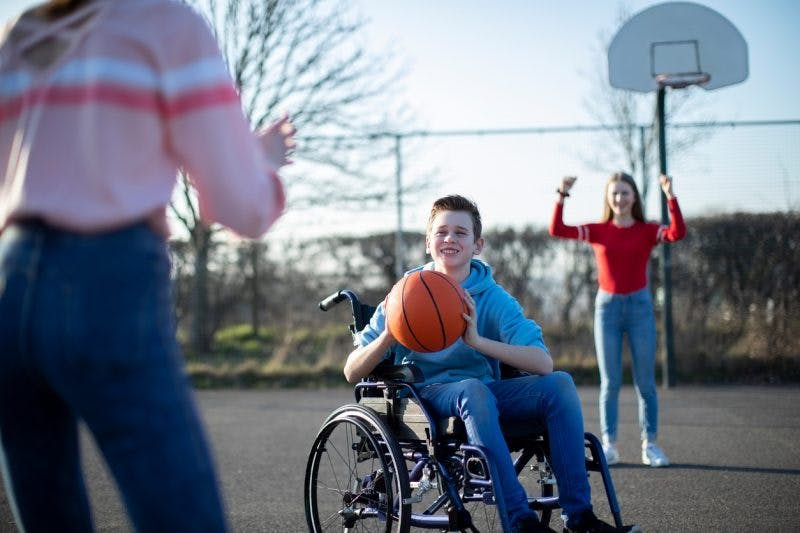The best sports for cerebral palsy are the ones that keep your child active, engaged, and safe.
Cerebral palsy is a movement disability that can vary from mild to severe. Everyone experiences cerebral palsy differently and therefore, has different levels of mobility. Some individuals may be able to walk, while others may need to use a wheelchair.
Cerebral palsy can also affect various areas of the body. For example, some people are only affected in the legs and can control their upper body without difficulty. In contrast, others may have motor impairments on only one side of their body or lack control all over.
This article will go over some of the most popular sports among individuals with cerebral palsy.
Cerebral Palsy Sports Classification System
One of the main goals of adaptive sports is to prioritize inclusion by accommodating each individual’s unique abilities.
This is only possible if the competition is fair and relatively evenly matched.
Because functional abilities in individuals with cerebral palsy can vary so much, organizations develop classification systems to place children with CP in sports against competitors with relatively similar functional levels.
Below is the United States Cerebral Palsy Athlete Association’s 8-level classification system.
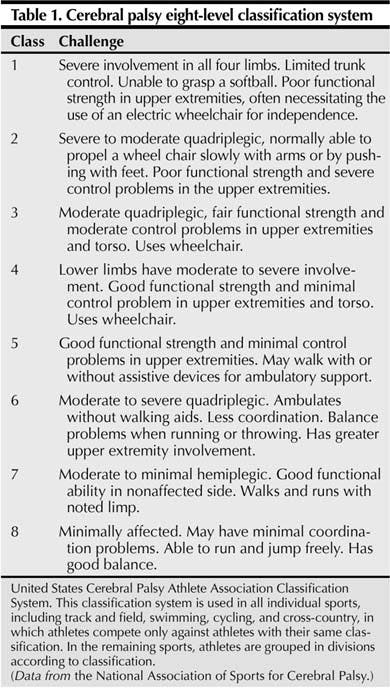
Adaptive Sports for Cerebral Palsy
Ultimately, the best sport for people with cerebral palsy is going to depend on each individual’s preference.
Your child may have cerebral palsy, but that doesn’t mean they should only be able to play certain sports. They can enjoy any sport they want as long as they’re willing to try and adapt.
There are tons of adaptive sports that encourage people with cerebral palsy be included, have fun, and stay active.
1. Swimming
Swimming is a great sport for individuals with cerebral palsy because the buoyant force of water reduces the amount of pressure on the joints.
This enables people with cerebral palsy to focus on form without being weighed down by the effects of gravity.
Water also promotes more fluid movement patterns, which can help reduce stiff motions.
Due to water resistance, swimming is a full-body workout that helps promote cardiovascular health, endurance, and muscle strength.
Although getting into the pool may not seem like the safest idea for individuals with motor impairments, there are many safety measures that can be used. This includes the use of flotation devices and ensuring a caregiver, instructor, or therapist is attentively watching and positioned nearby.
2. Running
About 50-60% of people with cerebral palsy can walk on their own. However, it’s possible that even more than that can run.
How’s this possible? The brain damage that causes cerebral palsy does not worsen or improve over time, but it may need some time to stabilize.
In The Boy Who Could Run But Not Walk, Dr. Karen Pape suggests that walking is a skill learned so early in life that the brain has not had a chance to fully stabilize from the damage.
In contrast, running can be developed years later (when the brain damage is stabilized) and utilizes different neural pathways than those for walking. Therefore, many individuals demonstrate better form running than they do walking.
The following video is about a high school runner with cerebral palsy:
After high school, Justin attended the University of Oregon and became the 1st Nike athlete with cerebral palsy.
3. Cycling
Cycling is a fun, low-impact sport that many people with cerebral palsy can enjoy.
There are many different types of bikes to accommodate various types of motor impairments. For example, those with paralysis in their legs can use a handcycle.
Individuals that have lower extremity movement but struggle with balance can use a recumbent bicycle, which is positioned lower to the ground to provide more stability and has a seat that supports the entire back.
There is a lot of versatility in cycling, as it can be completed indoors or outdoors, and as a social activity or independently.
Cycling helps develop balance, gets the heart beating, and promotes endurance.
4. Horseback Riding
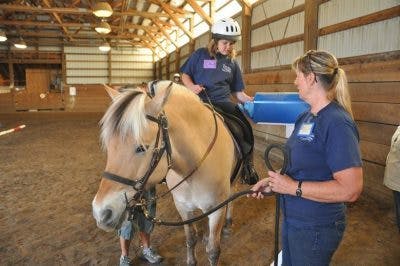
photo by: 2nd Lt. Shelley Gregory
Horseback riding can be a great sport for children with cerebral palsy because it helps develop balance, strength, and posture.
In fact, there’s an entire therapy based on horseback riding called hippotherapy.
Horseback riding encompasses many factors that can be helpful for children with cerebral palsy.
Because the horse is moving, children have to constantly adjust their center of gravity to stay balanced. These micromovements help develop core strength.
Additionally, interacting with the horse will keep your child engaged so that they want to practice more. Repetition is key to improving movement patterns.
Once your child masters the basics, they can even compete in para-equestrian sports!
5. Archery
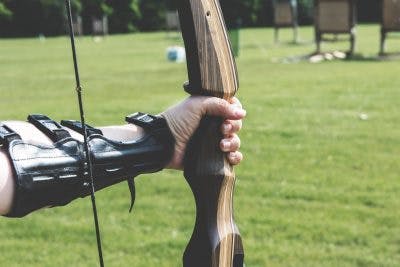
Archery is a great sport for individuals with cerebral palsy because it can be performed standing or sitting in a wheelchair.
It helps develop hand-eye coordination, grip, and upper body strength.
Individuals who are affected on one side of the body can use a customized glove or splint to help carry and use the bow and arrows. They can even use their mouth to pull the string back and release.
Should Individuals with Cerebral Palsy Play Sports?
Although individuals with cerebral palsy have motor impairments, it’s essential that they exercise for their overall health.
Physical inactivity is a major risk factor for complications like heart disease, high blood pressure, and osteoporosis.
Especially as individuals with cerebral palsy get older, functional abilities can decrease. Although the brain damage that caused cerebral palsy will not progress, physical inactivity can lead to weight gain and poor activity tolerance.
Exercise can help people with cerebral palsy:
- promote circulation
- improve metabolic rate
- increase joint range of motion
- strengthen underused muscles
- improve bone density
- relieve stress and anxiety
- boost energy levels
- improve overall mobility
Participating in sports is a great way to promote exercise and develop social skills.
Cerebral Palsy and Sports: Key Points
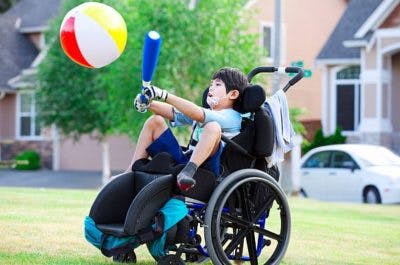
Every sport has a learning curve, so it’s essential to give it a chance before dismissing it altogether.
Encourage your child to participate in whatever sport they want. Chances are, there’s an adaptive version of it.
Cerebral palsy can definitely make participating sports more difficult. However, with the right resources and support, your child can learn how to safely participate and live a more active lifestyle.
